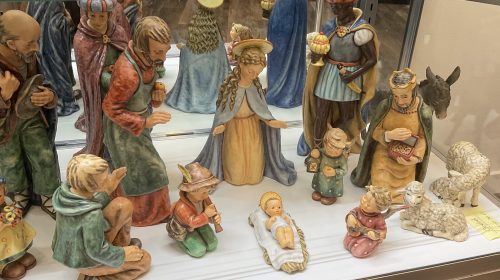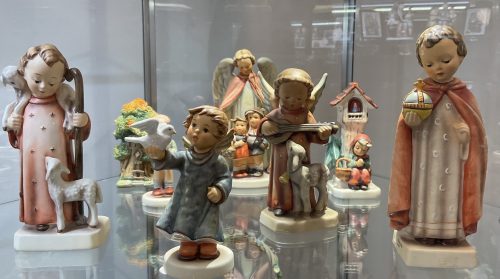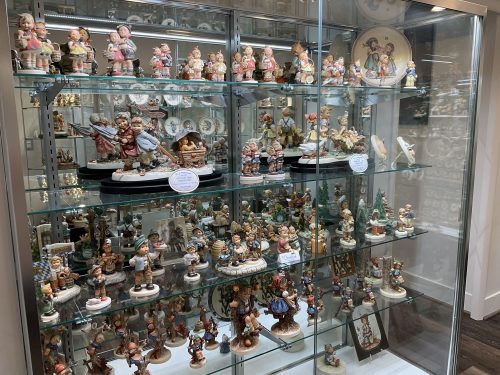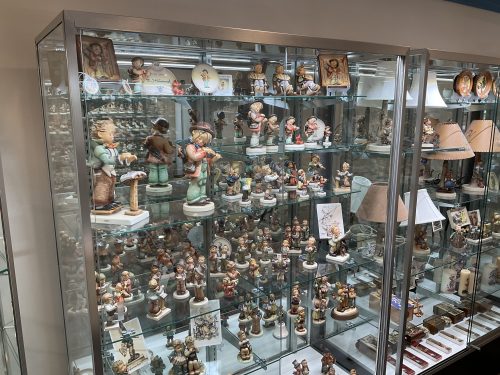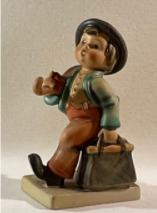Hummel Hall is now OPEN!
Visit Monday-Friday 9am-3pm and Sunday mornings between worship services!
Please call the church at 313.567.3100 for questions!
History of Hummel Figurines
Civil and political unrest after WWI, and the storm clouds of an impending WWII in Germany were the backdrop for the emergence of a budding art student, Bertha Hummel, known for her postcards of children. They were touching in their innocence and caught the attention of Franz Goebel, the fourth-generation family member and head of Goebel Porcelain Company at that time. It struck him that her art drawings and post cards would be perfect for the basis of a new line of figurines showing children in a simple and joyful manner. By 1934, Bertha Hummel had joined the Sisters of the Third Order of St. Francis at the Convent of Siessen and had taken the religious name of Sister Maria Innocentia Hummel. In conjunction with the Mother Superior of the Convent, Sister Hummel, and representatives from the Goebel Company agreed that Goebel artists would craft her two-dimensional drawings into three dimensional figurines. Sister Hummel and the Convent of Siessen had final artistic control – and that remains true to this day.
The introduction of M.I. Hummel figurines in 1935 at the Leipzig Fair, a major international trade show, was a tremendous success. Yet, the weight of Germany’s increasing political/social unrest had a significantly negative effect on Sister Hummel’s artwork. Her depictions of innocent, chubby, gentle-eyed, ruddy-cheeked German children provided an aura of tranquility and kindness during a time of turmoil. Hitler was greatly vexed by her art work. The Aryan vision of Hitler’s Germany was not a reflection of what he saw as depicting German children as having “hydrocephalic heads.” It was not his vision of Nazi Youth. Perhaps it was the figurines’ innocence and gentility that her art work evoked that also upset him. Sister Hummel became an anti-Nazi critic and an inspiration to all. Through her artistic creativity, this young Franciscan nun, Sister Maria Innocentia Hummel helped remind the world of God’s loving kindness during such a dark time in the world. This projection of loving kindness has continued to be a reminder to this day that God has used her to show us His beauty, silence, strength and gentility.
Donations
Jim Stokes and the late Fred Hoffman have had a passionate fascination with Hummel’s for 35 years, which has led to a unique collection of over 1,400 figurines, pictures, plates and other unique treasures. The collection started with just a few figurines and snowballed from there. The collection includes figurines with all nine Manufaktur marks, unique artist inscriptions, figurines made only available through a military PX and other special markings. The collection is not limited to just Hummel figurines but contains Hummel lamps, ashtrays, plates, plaques, holy water fonts, ornaments, dolls, bookends, two dimensional reproductions, post cards, scapes, wall hangings and other memorabilia. As varied as the items are in the collection, so too is the story from which many were acquired. Pieces have been acquired directly from the Manufaktur, Hummel organizations, other collections and collectors, antique shops throughout Germany, Canada, America, and several European countries, as well as retail stores and even barn sales in Stuttgart, Germany. The hope and goal of the gifting of their collection to Historic Trinity is that it will continue to bring visitors a sense of peace and hope, not only as they discover the uniqueness of each Hummel’s joyful expression, but also as they find these things in the Christian values of Historic Trinity.
Tie-in with HT
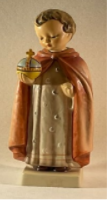
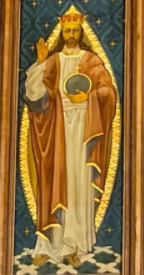
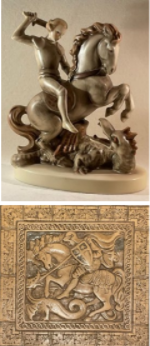
Just as each Hummel is hand formed and hand painted, leading to one-of-a-kind creations, Historic Trinity is also filled with hand carved, one-of-a-kind artistries. From the hand chiseled Italian marble of the Altar and Baptismal font to the hand carved wood traceries of the reredos. Local artisans were features when available, including the local art institution of Pewabic Pottery for tile insets of the slate floor of the sanctuary. In the sacristy, off to the side of the hand carved Communion rail, is a large Pewabic Pottery tile depicting St. George slaying the dragon representing Satan. As the communicants of Trinity leave the Communion rail, they stomp on Satan with the strength received through Holy Communion. There is a beautiful Hummel of St. George (HUM 55) slaying the dragon featured in Hummel Hall. The story line that helps to connect Historic Trinity to the Hummel display continues further with ‘Holy Child’ (HUM 70) that is reminiscent of the center of the reredos of Trinity showing Jesus holding the world in his hands.
To Schedule a tour of Hummel Hall, contact Mariana
at 313-567-3100 or email mariana@historictrinity.org.
